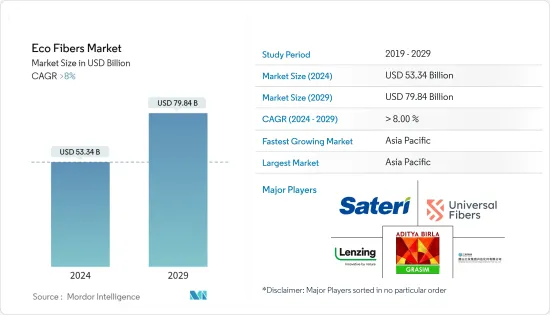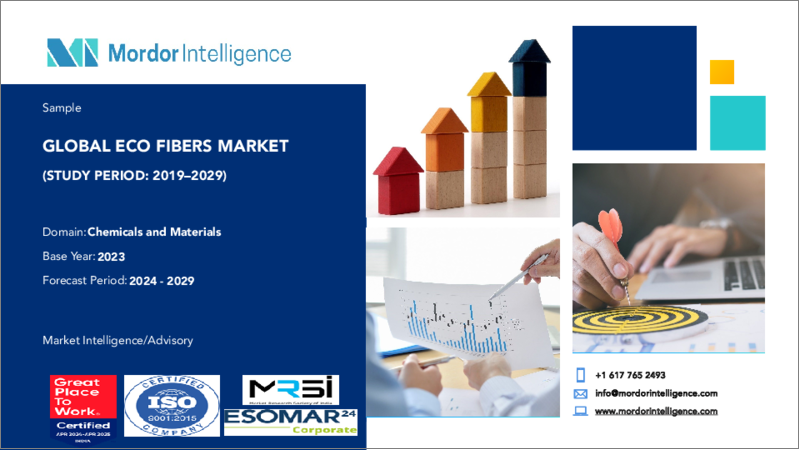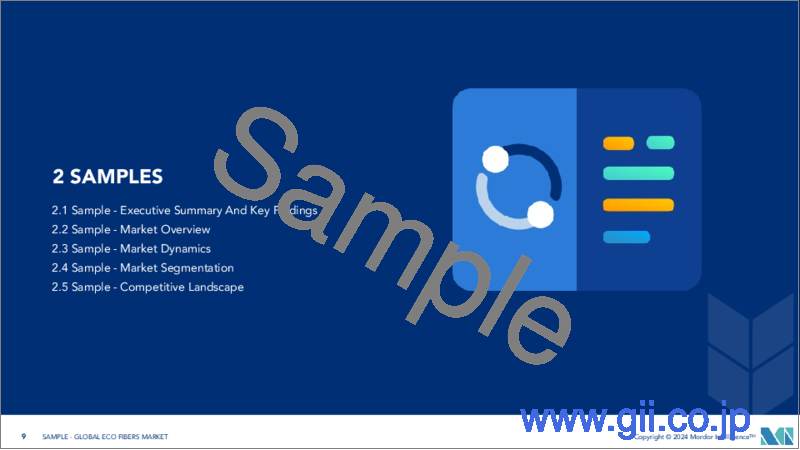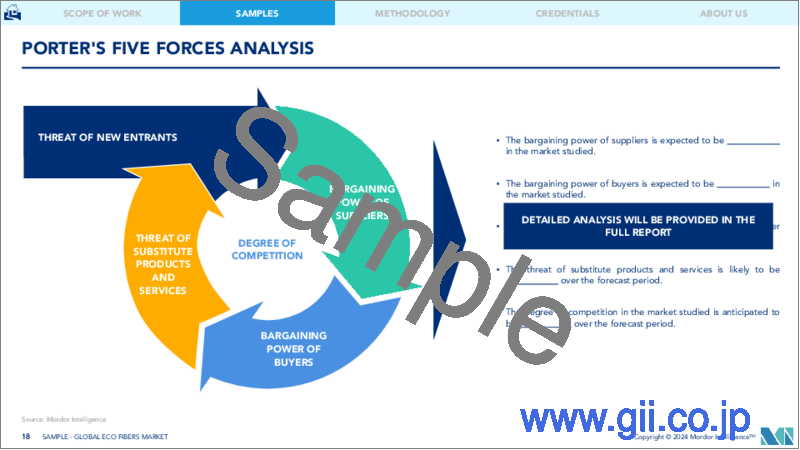|
|
市場調査レポート
商品コード
1537598
エコファイバー:市場シェア分析、産業動向と統計、成長予測(2024~2029年)Eco Fibers - Market Share Analysis, Industry Trends & Statistics, Growth Forecasts (2024 - 2029) |
||||||
カスタマイズ可能
適宜更新あり
|
|||||||
| エコファイバー:市場シェア分析、産業動向と統計、成長予測(2024~2029年) |
|
出版日: 2024年08月14日
発行: Mordor Intelligence
ページ情報: 英文 120 Pages
納期: 2~3営業日
|
全表示
- 概要
- 目次
エコファイバー市場規模は2024年に533億4,000万米ドルと推定され、2029年には798億4,000万米ドルに達すると予測され、予測期間中(2024-2029年)のCAGRは8%以上で成長します。

エコファイバー市場は、2020年にCOVID-19によってマイナスの影響を受けました。繊維産業はパンデミックの影響を最も大きく受けた産業の1つであり、衣料品のビジネス受注は世界市場で2桁減少しました。しかし、ほとんどの国の政府がこの産業を復活させるために様々な計画を開始し、それが後にこの分野の大幅な成長と改善につながった。例えば、欧州では、欧州連合(EU)と衣料品業界の労働条件改善プログラムであるベターワークが、バングラデシュやベトナムなどの国々の労働条件を改善するための取り組みに参加することを決定しました。こうした取り組みが衣料品業界の活性化につながり、結果的にエコファイバー需要を押し上げました。
長期的には、デイリーウェアやファッションウェアの需要の増加と、家庭用用途でのエコファイバーの使用の増加が、調査された市場を牽引すると予想されます。
最終製品の高コストは、今後数年間を通じてエコファイバーの市場成長を妨げると予想されます。
様々な用途における天然繊維の需要の高まりは、今後数年間で市場に機会を創出すると予想されます。
アジア太平洋は世界のエコファイバー市場を独占し、予測期間を通じて最も速い成長を記録するとも予想されます。
エコファイバー市場の動向
繊維産業からの需要の高まり
- エコファイバーは環境に優しく、持続可能性の向上に対する世界の関心の高まりから、繊維織物への使用が増加しています。
- エコファイバーは通常、麻、亜麻、オーガニックコットン、竹などさまざまな物質からできており、繊維の生産に使用されます。オーガニックコットンのような製品は、世界市場で従来のコットンに代わる持続可能な選択肢として支持を集めています。
- オーガニックコットンの生産は当初トルコで始まり、オーガニックコットン産業は現在、多くの発展途上国の繊維産業の基幹産業の地位を占めています。この分野はまた、いくつかの新興経済諸国の経済を活性化させる上で重要な役割を果たしています。
- International Journal of Novel Research and Developmentによると、インドにおける綿花生産量は、消費者需要の増加に牽引され、2030年までに720万トン(1俵170kg換算で4,300万俵)に達すると予測されています。また、中国国家統計局によれば、2022年の中国の綿花生産量は598万トン近くに達し、前年比4.3%増となります。
- 竹繊維は天然の抗菌素材として機能し、静菌・消臭効果があります。さらに、竹繊維は通気性、ソフトな肌触り、簡単な矯正を提供し、布地への優れた染料・顔料着色効果特性を持っています。
- 日常着の快適さに対する需要の開発、ファッションファブリックの技術進歩、先進地域における繊維化学物質に関する政府規制が、繊維産業における技術革新の需要を促進しており、これが今後数年間、エコファイバー市場を牽引すると予想されます。
- インド産業連盟(CII)によると、インドは世界第2位の繊維・衣料品生産国で、繊維・衣料品の世界貿易シェアは4%です。さらに、繊維・アパレル産業はインドのGDPに2.3%、工業生産に13%、輸出に12%貢献しています。
- さらに、米国の繊維・アパレル出荷額は2022年に658億米ドルに達しました。同国は世界第3位の繊維関連製品の輸出国です。繊維、織物、アパレルの輸出は2021年に340億米ドルでした。
- したがって、このようなすべての要因が予測期間中にエコファイバー市場を牽引すると予想されます。
アジア太平洋が市場を独占する
- アジア太平洋は、中国とインドの高度に発達した繊維産業が主な要因となって、世界市場を独占すると予想されます。さらに、綿花の生産量が多く、安価な労働力が利用できるため、製造業者は中国、インド、バングラデシュ、パキスタンなどの国に製造ユニットを設置することを好みます。
- 繊維製品に使用される様々な化学物質による環境問題の高まりや、人口の多くが様々な病気に罹患していることが、様々な用途におけるエコファイバーの需要を高めています。エコファイバーは人に優しく、生産段階でも環境にダメージを与えないです。
- エコファイバーは、防水シート、ジオテキスタイル、バッグ、カーペット、家具素材などの家庭用用途にも使用されています。中国は主に、インド、パキスタン、欧州などの国や地域に家庭用素材を輸出しています。
- さらに、インベスト・インディアの分析によれば、インドは2030年までに繊維製品の生産で2,500億米ドル、輸出で1,000億米ドルを達成する予定です。
- 包装もまた、持続可能な包装への需要の高まりにより、環境に優しい繊維への需要が最近勢いを増している分野です。Protega Global Ltd.によると、2023年1月、持続可能な包装を求める消費者の割合は81%に上昇しました。
- インド包装工業協会(PIAI)によると、包装はインド経済で5番目に大きなセクターと考えられており、年率22~25%程度で成長しています。
- さらに、世界貿易機関(WTO)のデータによると、中国は世界のエコファイバーテキスタイル市場をリードしています。
- 全体として、このような要因が予測期間中の市場成長を促進すると予想されます。
エコファイバー産業の概要
世界のエコファイバー市場は部分的に統合された性質を持っており、少数のプレーヤーが世界市場で大きなシェアを占めています。世界市場の主要企業(順不同)には、SATERIやAditya Birla Management Corporation Pvt.Ltd(Grasim Industries Limited)、Universal Fibers Inc.、LENZING AG(ECOVERO)、Tangshan Sanyou Group Xingda Chemical Fibreなどがあります。
その他の特典:
- エクセル形式の市場予測(ME)シート
- 3ヶ月間のアナリスト・サポート
目次
第1章 イントロダクション
- 調査の前提条件
- 調査範囲
第2章 調査手法
第3章 エグゼクティブサマリー
第4章 市場力学
- 促進要因
- デイリーウェアとファッションウェアの需要拡大
- 家庭用途の増加
- 抑制要因
- 最終製品のコスト高
- バリューチェーン分析
- ポーターのファイブフォース分析
- 供給企業の交渉力
- 消費者の交渉力
- 新規参入業者の脅威
- 代替品の脅威
- 競争企業間の敵対関係の強さ
第5章 市場セグメンテーション
- 種類別
- 有機繊維
- 再生繊維
- その他のタイプ
- 用途別
- テキスタイル
- 産業用
- 家庭用・家具
- その他の用途
- 地域別
- アジア太平洋
- 中国
- インド
- 日本
- 韓国
- 東南アジア諸国
- その他アジア太平洋地域
- 北米
- 米国
- カナダ
- メキシコ
- 欧州
- ドイツ
- 英国
- イタリア
- フランス
- ロシア
- その他欧州
- 南米
- ブラジル
- アルゼンチン
- その他南米
- 中東・アフリカ
- サウジアラビア
- 南アフリカ
- その他中東とアフリカ
- アジア太平洋
第6章 競合情勢
- M&A、合弁事業、提携、協定
- 市場シェア(%)/ランキング分析
- 主要企業の戦略
- 企業プロファイル
- LENZING AG
- Grasim Industries Limited
- Pilipinas Ecofiber Corporation
- Polyfibre Industries Private Limited
- SATERI
- Shanghai Tenbro Bamboo Textile Co.,Ltd.
- Tangshan Sanyou Group Xingda Chemical Fiber Co.,Ltd.
- TEIJIN FRONTIER CO., LTD.
- Universal Fibers, Inc.
- Wellman Advanced Materials
第7章 市場機会と今後の動向
- 様々な用途における天然繊維の需要拡大
- その他の機会
The Eco Fibers Market size is estimated at USD 53.34 billion in 2024, and is expected to reach USD 79.84 billion by 2029, growing at a CAGR of greater than 8% during the forecast period (2024-2029).

The eco fibers market was negatively impacted by COVID-19 in 2020. The textile industry was one of the industries to be worst affected by the pandemic, with business orders of garments dropping by double-digit numbers in the global market. However, the governments of most countries initiated various schemes to revive the sector, which later led to substantial growth and improvement in the sector. For instance, in Europe, the European Union (EU) and Better Work, a program to improve working conditions in the garment industry, decided to join efforts to improve working conditions in countries such as Bangladesh and Vietnam. Such initiatives helped revive the sector and consequently boosted eco-fiber demand.
Over the long run, growing demand for daily and fashion wear and increasing use of eco-fiber in household applications are expected to drive the market studied.
The high cost of final products is expected to hinder the market growth of eco fibers through the coming years.
Growing demand for natural fibers in various applications is expected to create opportunities for the market in the coming years.
Asia-Pacific is expected to dominate the global eco fibers market, and it is also expected to register the fastest growth through the forecast period.
Eco Fibers Market Trends
Growing Demand from Textile Industry
- Eco-fibers are environmentally friendly and have been increasingly used in textile fabrics because of the growing global focus on improved sustainability.
- Eco-fibers are usually made of different substances, such as hemp, flax, organic cotton, and bamboo, which are used in the production of fabrics. Products, such as organic cotton, are gaining traction and serve as a sustainable alternative to conventional cotton in the global market.
- Organic cotton production initially started in Turkey, and the organic cotton industry currently occupies the place of the backbone of the textile industry of many developing countries. The sector has also played an important role in boosting the economies of a few developing countries.
- According to the International Journal of Novel Research and Development, cotton production in India is projected to reach 7.2 million tons (43 million bales of 170 kg each) by 2030, driven by increasing consumer demand. Additionally, the National Bureau of Statistics of China stated that China produced nearly 5.98 million tonnes of cotton in 2022, up 4.3% yearly.
- Bamboo fiber works naturally as an anti-bacterial material and has properties of bacteriostatic and deodorant. Additionally, bamboo fibers offer permeability, a soft feel, and easy straightening and have excellent dye and pigmentation color effect properties to fabrics.
- Increasing demand for comfort in daily wear, technological advancements in fashion fabrics, and government regulations on textile chemicals in developed regions are driving the demand for innovations in the textile industry, which, in turn, is expected to drive the market for eco fibers through the years to come.
- According to the Confederation of Indian Industry (CII), India is the world's second-largest producer of textiles and garments and has a 4% share of the global trade in textiles and apparel. Furthermore, the textiles and apparel industry contributes 2.3% to India's GDP, 13% to industrial production, and 12% to exports.
- Furthermore, the United States' textile and apparel shipments totaled USD 65.8 billion in 2022. The country is the third largest exporter of textile-related products in the world. Fiber, textile, and apparel exports were USD 34.0 billion in 2021.
- Thus, all such factors are expected to drive the eco fibers market during the forecast period.
Asia-Pacific to Dominate the Market
- Asia-Pacific is expected to dominate the global market, largely driven by the highly developed textile industry in China and India. Moreover, manufacturers prefer to set up manufacturing units in countries like China, India, Bangladesh, and Pakistan, owing to high cotton production and availability of cheap labor.
- Growing environmental issues because of various chemicals used in textiles and a large proportion of the population getting affected by various diseases are increasing the demand for eco fibers in different applications. Eco fibers are human-friendly and cause no damage to the environment, even during the production phase.
- Eco-fibers have also been used for household applications, such as tarpaulins, geotextiles, bags, carpets, and furniture materials. China majorly exports its household materials to other countries and regions, like India, Pakistan, Europe, etc.
- Furthermore, as per Invest India's analysis, India is set to achieve USD 250 billion in textiles production and USD 100 billion in exports by 2030.
- Packaging is another sector where the demand for eco-friendly fibers is recently gaining momentum due to the increasing demand for sustainable packaging. According to Protega Global Ltd., in January 2023, the percentage of consumers demanding sustainable packaging was risen to 81%.
- Packaging is considered the fifth largest sector in the Indian economy and is growing around 22-25% per annum, according to the Packing Industry Association of India (PIAI).
- Additionally, according to World Trade Organization (WTO) data, China leads the global eco-fiber textile market.
- Overall, such factors are expected to drive market growth during the forecast period.
Eco Fibers Industry Overview
The global eco fibers market is partially consolidated in nature, with few players having a significant share in the global market. Some of the major players in the global market (not in any particular order) include SATERI and Aditya Birla Management Corporation Pvt. Ltd (Grasim Industries Limited), Universal Fibers Inc., LENZING AG (ECOVERO), and Tangshan Sanyou Group Xingda Chemical Fibre Co. Ltd., among others.
Additional Benefits:
- The market estimate (ME) sheet in Excel format
- 3 months of analyst support
TABLE OF CONTENTS
1 INTRODUCTION
- 1.1 Study Assumptions
- 1.2 Scope of the Study
2 RESEARCH METHODOLOGY
3 EXECUTIVE SUMMARY
4 MARKET DYNAMICS
- 4.1 Drivers
- 4.1.1 Growing Demand from Daily and Fashion Wear
- 4.1.2 Increasing Household Applications
- 4.2 Restraints
- 4.2.1 High Cost of Final Products
- 4.3 Industry Value Chain Analysis
- 4.4 Porter's Five Forces Analysis
- 4.4.1 Bargaining Power of Suppliers
- 4.4.2 Bargaining Power of Consumers
- 4.4.3 Threat of New Entrants
- 4.4.4 Threat of Substitute Products and Services
- 4.4.5 Intensity of Competitive Rivalry
5 MARKET SEGMENTATION (Market Size in Value)
- 5.1 Type
- 5.1.1 Organic Fibers
- 5.1.2 Recycled Fibers
- 5.1.3 Other Types
- 5.2 Application
- 5.2.1 Textiles
- 5.2.2 Industrial
- 5.2.3 Household and Furnishing
- 5.2.4 Other Applications
- 5.3 Geography
- 5.3.1 Asia-Pacific
- 5.3.1.1 China
- 5.3.1.2 India
- 5.3.1.3 Japan
- 5.3.1.4 South Korea
- 5.3.1.5 ASEAN Countries
- 5.3.1.6 Rest of Asia-Pacific
- 5.3.2 North America
- 5.3.2.1 United States
- 5.3.2.2 Canada
- 5.3.2.3 Mexico
- 5.3.3 Europe
- 5.3.3.1 Germany
- 5.3.3.2 United Kingdom
- 5.3.3.3 Italy
- 5.3.3.4 France
- 5.3.3.5 Russia
- 5.3.3.6 Rest of Europe
- 5.3.4 South America
- 5.3.4.1 Brazil
- 5.3.4.2 Argentina
- 5.3.4.3 Rest of South America
- 5.3.5 Middle-East and Africa
- 5.3.5.1 Saudi Arabia
- 5.3.5.2 South Africa
- 5.3.5.3 Rest of Middle-East and Africa
- 5.3.1 Asia-Pacific
6 COMPETITIVE LANDSCAPE
- 6.1 Mergers and Acquisitions, Joint Ventures, Collaborations, and Agreements
- 6.2 Market Share (%)**/Ranking Analysis
- 6.3 Strategies Adopted by Leading Players
- 6.4 Company Profiles
- 6.4.1 LENZING AG
- 6.4.2 Grasim Industries Limited
- 6.4.3 Pilipinas Ecofiber Corporation
- 6.4.4 Polyfibre Industries Private Limited
- 6.4.5 SATERI
- 6.4.6 Shanghai Tenbro Bamboo Textile Co.,Ltd.
- 6.4.7 Tangshan Sanyou Group Xingda Chemical Fiber Co.,Ltd.
- 6.4.8 TEIJIN FRONTIER CO., LTD.
- 6.4.9 Universal Fibers, Inc.
- 6.4.10 Wellman Advanced Materials
7 MARKET OPPORTUNITIES AND FUTURE TRENDS
- 7.1 Growing Demand for Natural Fibers in Various Applications
- 7.2 Other Opportunities






